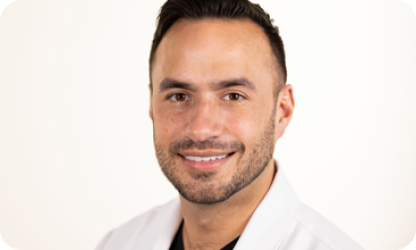Solar injury considerably impacts our pores and skin. It may hurt cells and proteins, contribute to pores and skin most cancers, and speed up the pores and skin’s pure ageing course of by as much as 80%. (Supply) So, no matter your age or pores and skin kind, there’s one factor that you must at all times embody in your day by day skincare routine: sunscreen.
Actually, if there’s one factor dermatologists agree on, it’s that sunscreen is without doubt one of the greatest methods to assist defend your self. “If you’re going to spend money on anyone product on your pores and skin, it needs to be sunscreen. This step is probably the one true want in skincare,” advises Dr. Luke J. Maxfield, board-certified dermatologist.
Be a part of us as we chat with Dr. Maxfield and extra specialists to search out out what makes a dermatologist-recommended sunscreen. Learn on to search out out what you must search for in your day by day solar care merchandise.
Meet the specialists:

Dr. Joyce Park
Board-certified dermatologist based mostly in Washington, founder and CEO of Pores and skin Refinery, a digital dermatology clinic, and a skincare and wonder content material creator at Tea with MD.

Dr. Caroline Robinson
Chicago-based, board-certified medical and beauty dermatologist with subspecialty experience in alopecia, preventative skincare, and ethnic pores and skin dermatology.

Dr. Luke Maxfield
Board-certified dermatologist who served on the Dermatology in Overview advisory board and is printed in over 15 medical journals.
The dermatologist guidelines for advisable sunscreens:
1. It’s broad spectrum
First issues first, what is broad safety sunscreen? It’s the one form of sunscreen advisable in The American Academy of Dermatology’s (AAD) pointers on sunscreen, and with good cause: it protects your pores and skin from each UVA and UVB rays.
The photo voltaic radiation that reaches us each day is made up of various rays, which have an effect on our pores and skin in several methods. UVA rays are largely answerable for untimely pores and skin ageing, so that they provoke adjustments within the pores and skin, similar to the looks of wrinkles and solar spots. UVB rays are typically referred to as burning rays, as they’re the offender behind sunburn and tanning in your pores and skin.
Each sorts of rays can contribute to the chance of creating pores and skin most cancers. So, for the perfect all-over safety, make sure to select broad spectrum sunscreens.
☀️ Verify your native UV index now
2. The upper the SPF, the higher
One of many greatest misconceptions about sunscreen is that in case you have pores and skin of coloration, you don’t must be utilizing a excessive SPF. However, the AAD recommends that everybody makes use of an SPF of at the very least 30.
SPF, or solar safety issue, is a measurement of the period of time that your sunscreen will assist defend your pores and skin from photo voltaic radiation. When making your alternative, it’s greatest to search for the next SPF, similar to an SPF 50 or SPF 50+ sunscreen, as this will increase the time it might take on your pores and skin to burn when in direct daylight.

Along with SPF numbers, there’s one other helpful SPF tip to think about. It’s actually essential to apply sunscreen precisely because it says on the label as that is the best way the sunscreen has been examined. So to get the identical degree of safety, it is advisable apply following the directions.
3. Pores and skin-boosting elements are included
To get the utmost profit out of your sunscreen, search for one with extra elements that enhance total pores and skin well being. Essentially the most superior formulations now assist care on your pores and skin in different methods, including peptides to assist goal indicators of untimely pores and skin ageing, and antioxidants, for further safety in opposition to oxidative pores and skin injury.
“I like to recommend Eryfotona Actinica to my sufferers for its distinctive enzyme referred to as DNA Repairsomes®,” says Dr. Park. And what makes DNA Repairsomes® so particular? Often known as photolyase, this naturally-occurring enzyme is derived from plankton and has been clinically confirmed to assist restore UV-induced injury within the pores and skin.
Dr. Maxfield sums it up greatest, “Eryfotona sunscreens present a really distinctive protection for the pores and skin, not solely by way of the mix of zinc oxide and antioxidants but additionally by way of serving to to restore solar injury with data-driven DNA Repairsomes®.”

4. The feel makes you need to put on it
The very best form of sunscreen is one you’ll need to apply each single day. And that’s the place professional insights come into play.
Dermatologists are at all times on prime of the most recent improvements in product texture — similar to 100% mineral sunscreens that don’t go away behind a greasy, white residue. “ISDIN Eryfotona Actinica is 100% mineral and ultralight. I like to recommend it to all my sufferers to guard and assist restore their pores and skin,” explains Dr. Robinson. Her private favourite? “Eryfotona Ageless. It’s 100% mineral and the tint blends with my pores and skin superbly.”

Backside line: To assist defend your pores and skin from solar injury and photoaging, a dermatologist-recommended sunscreen is a good place to start out. And bear in mind, the solar doesn’t take a day without work! So, whichever kind of sunscreen you select, apply it day by day, and apply it effectively.
Sources and references:
Flament, Frederic et al. “Impact of the solar on seen scientific indicators of ageing in Caucasian pores and skin.” Medical, beauty and investigational dermatology vol. 6 221-32. 27 Sep. 2013




